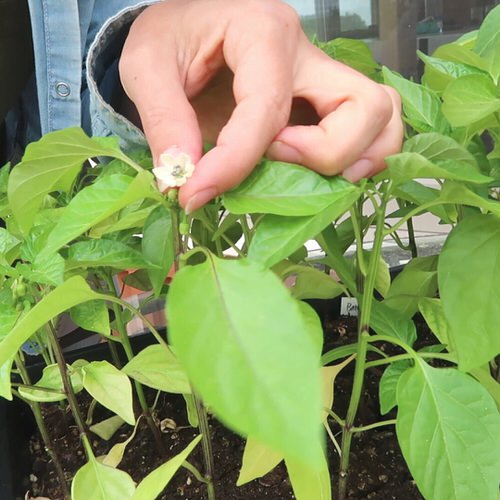Making your pepper plants full of fruits is not as tough as you think! Here are some scientifically-backed tricks to achieve that goal!

The methods in this article will ensure that your peppers produce more flowers, which will automatically equate to a plant full of fruits!
Best Peppers that Grow Upwards
Grow Bucket Full of Peppers with these Tricks
No, I won’t bore you with the usual tips, and will share the ones that ACTUALLY work!
1. Don’t Scoop Out the Garden Soil to Grow Them

Garden soil may help the plant sustain, but 100% of it won’t make the peppers grow wonderful fruits! Here’s what you need to do:
Take two parts of compost and mix with one part of coarse sand or perlite – these are the foundation of a good-quality growing medium for peppers. Now, add 1 part of peat moss or coconut coir to the mix – it will help to retain moisture.
Mix all of these well, and add one part of worm castings – it enhances the growing medium and promotes healthy plants and flowers. You can also add a handful of bonemeal, too.
2. Stress the Plant
When you ‘stress’ the plant, it goes into survival mode and grows more flowers to produce more fruits, which means – more seeds = more plants!
What you can do to trick peppers into producing more flowers is to reduce watering a little. Achieve this by allowing the growing medium to dry out slightly more than usual. (An inch of the tip of your finger in the topsoil to see if it’s dry before watering the plant).
Also, try keeping the plant slightly in a root-bound stage (One size tighter pot than required).
Peppers are generally grown in 12-inch pots – so, go for a 10-inch one. It will give the plant a limited space to expand its roots, which will help pepper focus on producing more flowers and fruits.
3. Pick the Right Fertilizer

Balanced liquid fertilizer may work for most plants, but for peppers, you need something specific.
See, phosphorous is crucial for flowering, so you need to pick a blend that has a higher concentration, along with potassium, as it also aids in the blooming process.
12-32-16, 4-6-3, and 7-4-5 are the blends you must focus on while growing peppers, but there’s a twist. Don’t just blindly follow the instructions on the package.
Dilute the feed to 1/4 of its strength and use it once in 2-3 weeks, from a month before the plant flowers. You can thank me later!
4. Snip Away the First Set of Flowers

Don’t worry. I’m not trying to rob you of tasty peppers! Hear me out!
Removing the first set of flowers tricks the plant into producing more future blooms and establishing itself – that’s how nature works!
It makes the plant focus on fewer flowers = fewer fruits. They will be bigger and of better quality, as the plant’s energy won’t be wasted to maintain multiple flowers, and it will focus it on keeping itself healthy, too.
It would help, too, if you cut off the top of peppers (topping) when they reach a height of about 6-8 inches to promote side shoots, leading to more space for flower buds to grow.
5. Attract Bees and Butterflies!
You must self-pollinate the plant (If you aren’t growing a self-pollinating variety) or attract bees and butterflies to do the job!
If you have a pepper plant indoors – use a small brush to transfer pollens. For the ones outdoors, grow these flowers and plants near peppers to attract pollinators.
Other Smaller and Significant Tips

6. Pepper plants can only grow better and fuller when they get proper sunlight – so expose them to at least 6 hours of direct sunlight daily, but the more, the better. Also, the hotter the area, the better, just like eggplants.
7. Companion plants are good for peppers. Basil can improve the taste and keep pests away and provide a fresh supply of sprigs for the kitchen – a win-win!
8. This nightshade family member is comparatively more compact than eggplants and tomatoes. Some varieties grow better in pots in limited space than others. Check different types of pepper here.
9. Go for a planned successive or staggered planting – do this by sowing pepper seeds at intervals (e.g., every two weeks). This will ensure that when one plant is finished with fruiting, the other one is ready to provide more!


